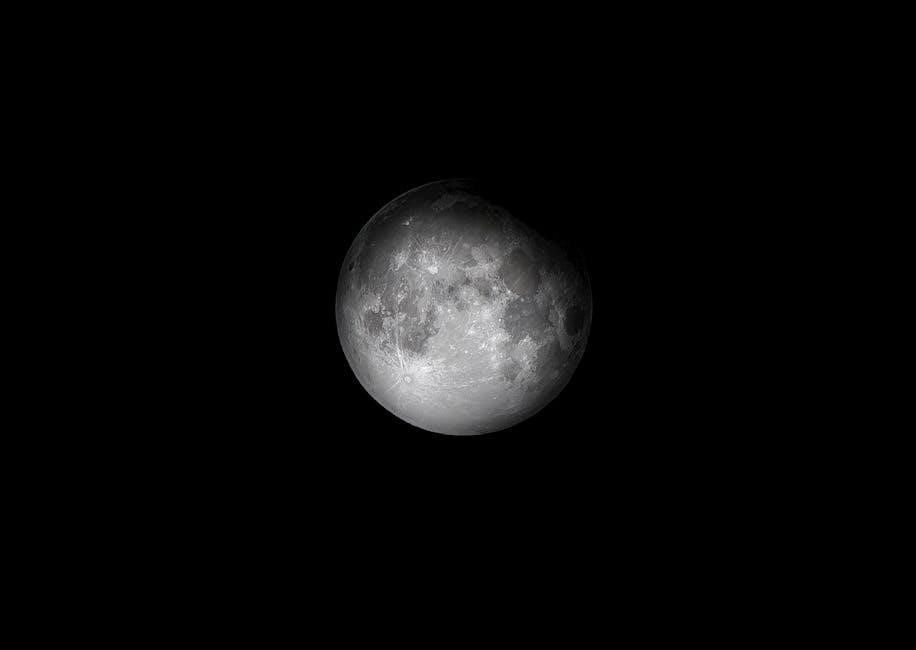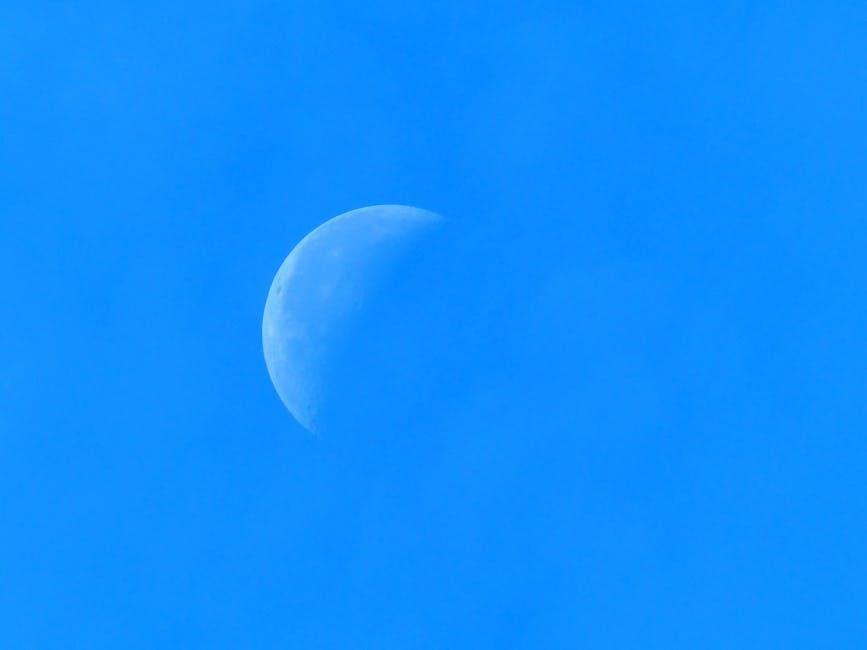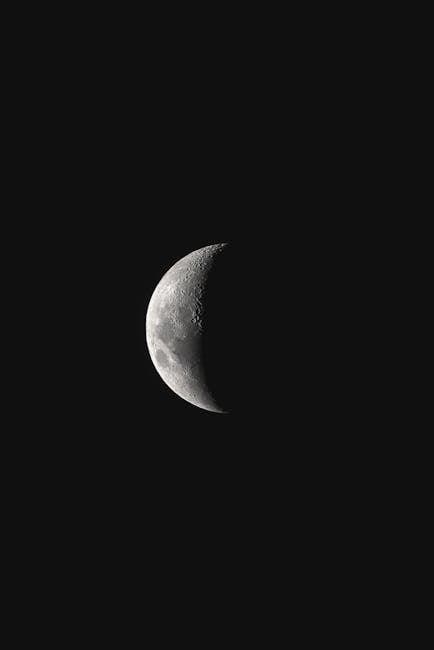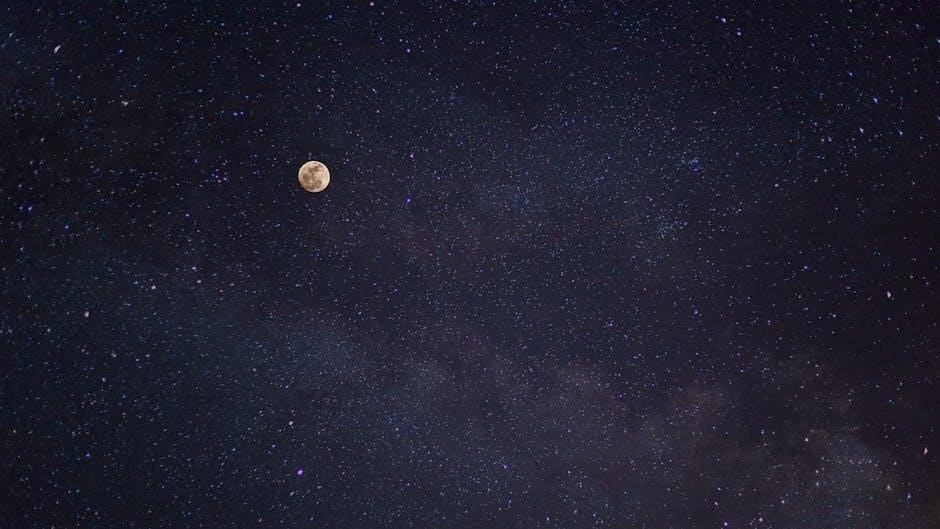Moon Phases Worksheet PDF: A Comprehensive Guide
Embark on a lunar journey with our comprehensive guide to moon phases worksheets in PDF format. These resources offer engaging activities to learn about the lunar cycle. Explore free, printable worksheets designed for both personal and classroom use, perfect for understanding the eight phases.

The moon, Earth’s celestial companion, undergoes a fascinating transformation throughout its monthly cycle, presenting us with an array of captivating shapes known as moon phases. These phases, from the mysterious New Moon to the radiant Full Moon, offer a visual spectacle that has intrigued observers for centuries. Understanding these phases is essential for comprehending the dynamic relationship between the Earth, the Moon, and the Sun.
Moon phases are not caused by the Earth’s shadow, but rather by the changing angles at which we view the moon’s illuminated surface as it orbits our planet. As the moon travels around the Earth, different portions of its sunlit side become visible to us, creating the illusion of a changing shape. This continuous cycle of waxing and waning provides a natural calendar, influencing various aspects of life on Earth, from tides to cultural traditions.
Engaging with moon phase worksheets offers an interactive way to explore this topic. These worksheets are designed to help learners of all ages visualize and internalize the sequence of lunar phases. Free printable resources make this learning accessible, offering a hands-on approach to understanding the cosmos.
Understanding the Lunar Cycle
The lunar cycle, a continuous and mesmerizing dance between the Earth, Moon, and Sun, spans approximately 29.5 days, known as a synodic month. This cycle governs the sequence of moon phases, each phase representing a unique perspective of the Moon’s illuminated surface. Comprehending the lunar cycle is pivotal in grasping how the interplay of these celestial bodies dictates the Moon’s appearance from our vantage point.
As the Moon orbits the Earth, the amount of sunlight reflected towards us varies, giving rise to the different phases. The cycle commences with the New Moon, when the Moon is positioned between the Earth and Sun, rendering it invisible to us. Subsequently, as the Moon progresses in its orbit, a sliver of light appears, marking the Waxing Crescent phase. This illuminated portion gradually increases, leading to the First Quarter Moon. The light continues to grow, becoming the Waxing Gibbous phase, before culminating in the Full Moon, where the entire face is illuminated.
Following the Full Moon, the illuminated area begins to decrease, transitioning into the Waning Gibbous phase, then the Last Quarter Moon; Finally, it becomes the Waning Crescent phase, before returning to the New Moon. Moon phase worksheets serve as an invaluable tool in understanding the intricacies of this cycle.

The Eight Phases of the Moon
The lunar cycle is traditionally divided into eight distinct phases, each characterized by its unique appearance and position relative to the Earth and Sun. These phases, in sequential order, are New Moon, Waxing Crescent, First Quarter, Waxing Gibbous, Full Moon, Waning Gibbous, Last Quarter, and Waning Crescent. Understanding these phases provides insights into the Moon’s journey and its interaction with sunlight.
The New Moon marks the beginning of the cycle, when the Moon is virtually invisible from Earth. As the Moon orbits, a sliver of light emerges, creating the Waxing Crescent. The illumination grows to the First Quarter, where half of the Moon is visible. The Waxing Gibbous follows, with more than half illuminated, leading to the Full Moon, a fully lit spectacle.
Post-Full Moon, the light begins to wane, transitioning into the Waning Gibbous. The illumination decreases to the Last Quarter, again showing half the Moon. Finally, the Waning Crescent appears, a shrinking sliver of light before returning to the New Moon. Moon phase worksheets are designed to illustrate these transitions, providing a visual and interactive way to learn the eight phases.
New Moon: The Beginning
The New Moon signifies the start of the lunar cycle, a phase where the Moon appears darkest to observers on Earth. This occurs when the Moon is positioned between the Earth and the Sun, resulting in the side facing Earth not being illuminated by sunlight. While the Moon is technically still present in the sky, its lack of illumination renders it virtually invisible to the naked eye.
During the New Moon, the Moon is aligned with the Sun, making it rise and set at approximately the same time. This alignment also means that the far side of the Moon, the side we never see from Earth, is fully illuminated by the Sun during this phase. The New Moon is an important marker in various cultures and calendars, often associated with new beginnings and fresh starts.
Moon phase worksheets often depict the New Moon as a completely dark circle, symbolizing its absence of light. These worksheets help students understand the sequence of the lunar cycle and the relative positions of the Earth, Moon, and Sun. Activities might include coloring the New Moon black or identifying it among other phases. This phase provides a foundational understanding for grasping the subsequent phases of the Moon.
Waxing Crescent and First Quarter
Following the New Moon, the lunar cycle progresses into the Waxing Crescent phase. This phase is characterized by a sliver of light gradually appearing on the right side of the Moon. “Waxing” signifies that the illuminated portion is increasing, while “Crescent” refers to the curved shape of the visible light. As days pass, the crescent grows larger, leading to the next significant phase, the First Quarter Moon.
The First Quarter Moon occurs when exactly half of the Moon’s face is illuminated, appearing as a half-circle in the sky. At this point, the Moon has completed one-quarter of its orbit around the Earth since the New Moon. The First Quarter Moon rises around noon and sets around midnight, making it easily observable in the evening sky.
Worksheets focused on these phases often include activities that involve drawing or identifying the crescent shape and the half-moon. Students may be asked to color the illuminated portions or label diagrams illustrating the positions of the Earth, Moon, and Sun during these phases. These activities reinforce understanding of how the Moon’s appearance changes as it orbits the Earth, solidifying their grasp of the lunar cycle.

Waxing Gibbous and Full Moon
After the First Quarter, the Moon enters the Waxing Gibbous phase, where more than half of its surface is illuminated. The term “gibbous” describes a shape that is more than half but less than fully illuminated. As the Moon continues its orbit, the illuminated area steadily increases, leading to the spectacular Full Moon.
The Full Moon is perhaps the most recognizable and celebrated lunar phase. It occurs when the Earth is positioned directly between the Sun and the Moon, causing the entire face of the Moon to be illuminated. The Full Moon rises around sunset and sets around sunrise, remaining visible throughout the night. This phase is often associated with folklore, myths, and cultural significance across various societies.
Worksheets focusing on these phases commonly feature activities that involve comparing and contrasting the Waxing Gibbous and Full Moon. Students may be asked to identify the characteristics of each phase, such as the amount of illuminated surface and the time of day when they are visible. Activities might also explore the cultural significance of the Full Moon and its impact on tides.
Waning Gibbous and Last Quarter
Following the Full Moon, the lunar cycle transitions into the Waning Gibbous phase. During this period, the illuminated portion of the Moon begins to decrease, but it remains more than half-lit. “Waning” signifies that the light is diminishing, gradually leading towards the next major phase.
The Last Quarter, also known as the Third Quarter, occurs when the Moon has completed three-quarters of its orbit around the Earth. At this stage, only half of the Moon’s face is visible, appearing as a half-circle in the sky. However, the illuminated side is opposite to that of the First Quarter. The Last Quarter rises around midnight and sets around noon.
Worksheets dedicated to these phases often include exercises that help students differentiate between waxing and waning phases. Activities can involve identifying the order of phases, labeling diagrams, and explaining the changing positions of the Sun, Earth, and Moon. Engaging questions can also explore the connection between lunar phases and observable phenomena, such as tides.
Waning Crescent: The End of the Cycle
As the lunar cycle nears completion, the Moon enters its final visible phase: the Waning Crescent. This phase is characterized by a small, shrinking sliver of light, appearing as a thin crescent in the sky. The term “waning” continues to indicate the diminishing illumination as the Moon progresses towards the New Moon. The Waning Crescent is best observed in the early morning hours, just before sunrise.
This phase marks the end of the current lunar cycle and the imminent return to the New Moon, where the cycle begins anew. Worksheets focusing on the Waning Crescent often incorporate activities that reinforce the cyclical nature of lunar phases. These may include sequencing exercises, where students arrange the phases in the correct order, or drawing activities, where they illustrate the appearance of the Waning Crescent in relation to the Earth and Sun.
Educational materials might also explore cultural significance, such as stories and folklore associated with the Waning Crescent. Understanding this phase completes the learner’s grasp of the entire lunar cycle, setting the stage for further exploration of celestial phenomena.
Utilizing Moon Phase Worksheets (PDF)
Moon phase worksheets in PDF format are invaluable tools for educators and parents aiming to teach children about the lunar cycle. These worksheets offer a hands-on approach to learning, engaging students through visual aids, diagrams, and interactive activities. The PDF format ensures easy accessibility and printability, making them convenient for both classroom and home use. Worksheets can include a variety of exercises, such as labeling the different phases of the moon, matching phases to their descriptions, or even creating their own moon phase calendars.
Furthermore, some worksheets incorporate real-world applications by connecting moon phases to tides, planting cycles, or cultural traditions. Incorporating cut-and-paste activities is another approach that makes learning fun, especially for younger children. Worksheets can also assess comprehension through quizzes and short answer questions. These can serve as effective assessment tools to gauge students’ understanding.
The versatility of moon phase worksheets allows educators to tailor lessons to different age groups and learning styles. By utilizing these resources, instructors can create a well-rounded educational experience that fosters curiosity about the cosmos.
Free Printable Resources and Activities
Numerous free printable resources and activities are available online to enhance the learning experience related to moon phases. These resources often come in the form of PDF worksheets, providing educators and parents with accessible and engaging materials. Activities can range from simple coloring pages illustrating the different phases to more complex exercises involving labeling diagrams or answering comprehension questions. Many websites offer a variety of moon phase worksheets tailored to different age groups and skill levels.

In addition to worksheets, interactive activities like cut-and-paste exercises, matching games, and even Oreo cookie moon phase demonstrations are readily available. These hands-on activities make learning about the lunar cycle fun and memorable. Many resources include answer keys, allowing for easy assessment and self-checking.
Teachers Pay Teachers is a great place to find these resources. NASA also provides educational materials related to space exploration, including information about moon phases. By utilizing these free resources, educators and parents can create a rich and engaging learning environment for children of all ages.
